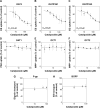Organic anion transporter 3- and organic anion transporting polypeptides 1B1- and 1B3-mediated transport of catalposide
- PMID: 25653502
- PMCID: PMC4310350
- DOI: 10.2147/DDDT.S75400
Organic anion transporter 3- and organic anion transporting polypeptides 1B1- and 1B3-mediated transport of catalposide
Abstract
We investigated the in vitro transport characteristics of catalposide in HEK293 cells overexpressing organic anion transporter 1 (OAT1), OAT3, organic anion transporting polypeptide 1B1 (OATP1B1), OATP1B3, organic cation transporter 1 (OCT1), OCT2, P-glycoprotein (P-gp), and breast cancer resistance protein (BCRP). The transport mechanism of catalposide was investigated in HEK293 and LLC-PK1 cells overexpressing the relevant transporters. The uptake of catalposide was 319-, 13.6-, and 9.3-fold greater in HEK293 cells overexpressing OAT3, OATP1B1, and OATP1B3 transporters, respectively, than in HEK293 control cells. The increased uptake of catalposide via the OAT3, OATP1B1, and OATP1B3 transporters was decreased to basal levels in the presence of representative inhibitors such as probenecid, furosemide, and cimetidine (for OAT3) and cyclosporin A, gemfibrozil, and rifampin (for OATP1B1 and OATP1B3). The concentration-dependent OAT3-mediated uptake of catalposide revealed the following kinetic parameters: Michaelis constant (K m) =41.5 μM, maximum uptake rate (V max) =46.2 pmol/minute, and intrinsic clearance (CL int) =1.11 μL/minute. OATP1B1- and OATP1B3-mediated catalposide uptake also showed concentration dependency, with low CL int values of 0.035 and 0.034 μL/minute, respectively. However, the OCT1, OCT2, OAT1, P-gp, and BCRP transporters were apparently not involved in the uptake of catalposide into cells. In addition, catalposide inhibited the transport activities of OAT3, OATP1B1, and OATP1B3 with half-maximal inhibitory concentration values of 83, 200, and 235 μM, respectively. However, catalposide did not significantly inhibit the transport activities of OCT1, OCT2, OAT1, P-gp, or BCRP. In conclusion, OAT3, OATP1B1, and OATP1B3 are major transporters that may regulate the pharmacokinetic properties and may cause herb-drug interactions of catalposide, although their clinical relevance awaits further evaluation.
Keywords: OAT3; OATP1B1; OATP1B3; catalposide; drug transporters; herb–drug interaction.
Figures




Similar articles
-
Identification of Transporters Involved in Beraprost Sodium Transport In Vitro.Eur J Drug Metab Pharmacokinet. 2017 Feb;42(1):117-128. doi: 10.1007/s13318-016-0327-4. Eur J Drug Metab Pharmacokinet. 2017. PMID: 26961540
-
Evaluation of the transporter-mediated herb-drug interaction potential of DA-9801, a standardized dioscorea extract for diabetic neuropathy, in human in vitro and rat in vivo.BMC Complement Altern Med. 2014 Jul 17;14:251. doi: 10.1186/1472-6882-14-251. BMC Complement Altern Med. 2014. PMID: 25034211 Free PMC article.
-
Organic anion transporting polypeptides 1B1 and 1B3 play an important role in uremic toxin handling and drug-uremic toxin interactions in the liver.J Pharm Pharm Sci. 2014;17(4):475-84. doi: 10.18433/j3m89q. J Pharm Pharm Sci. 2014. PMID: 25579430
-
Clinical importance of OATP1B1 and OATP1B3 in drug-drug interactions.Drug Metab Pharmacokinet. 2011 Jun;26(3):220-7. doi: 10.2133/dmpk.DMPK-10-RV-094. Epub 2011 Feb 1. Drug Metab Pharmacokinet. 2011. PMID: 21297316 Review.
-
In vitro evidence for the role of OATP and OCT uptake transporters in drug-drug interactions.Expert Opin Drug Metab Toxicol. 2009 May;5(5):489-500. doi: 10.1517/17425250902911463. Expert Opin Drug Metab Toxicol. 2009. PMID: 19416085 Review.
Cited by
-
Predictive Modeling of HMG-CoA Reductase Inhibitory Activity and Design of New HMG-CoA Reductase Inhibitors.ACS Omega. 2023 Jul 18;8(30):27247-27255. doi: 10.1021/acsomega.3c02567. eCollection 2023 Aug 1. ACS Omega. 2023. PMID: 37546661 Free PMC article.
-
Autophagic flux inhibition and lysosomogenesis ensuing cellular capture and retention of the cationic drug quinacrine in murine models.PeerJ. 2015 Oct 6;3:e1314. doi: 10.7717/peerj.1314. eCollection 2015. PeerJ. 2015. PMID: 26500823 Free PMC article.
-
Inhibitory Effect of AB-PINACA, Indazole Carboxamide Synthetic Cannabinoid, on Human Major Drug-Metabolizing Enzymes and Transporters.Pharmaceutics. 2020 Oct 29;12(11):1036. doi: 10.3390/pharmaceutics12111036. Pharmaceutics. 2020. PMID: 33138123 Free PMC article.
-
Herb-Drug Interaction of Red Ginseng Extract and Ginsenoside Rc with Valsartan in Rats.Molecules. 2020 Jan 31;25(3):622. doi: 10.3390/molecules25030622. Molecules. 2020. PMID: 32023909 Free PMC article.
-
In Vitro Inhibitory Effects of APINACA on Human Major Cytochrome P450, UDP-Glucuronosyltransferase Enzymes, and Drug Transporters.Molecules. 2019 Aug 19;24(16):3000. doi: 10.3390/molecules24163000. Molecules. 2019. PMID: 31430908 Free PMC article.
References
-
- Kim SW, Choi SC, Choi EY, et al. Catalposide, a compound isolated from catalpa ovata, attenuates induction of intestinal epithelial proinflammatory gene expression and reduces the severity of trinitrobenzene sulfonic Acid-induced colitis in mice. Inflamm Bowel Dis. 2004;10(5):564–572. - PubMed
-
- Yang G, Choi CH, Lee K, Lee M, Ham I, Choi HY. Effects of Catalpa ovata stem bark on atopic dermatitis-like skin lesions in NC/Nga mice. J Ethnopharmacol. 2013;145(2):416–423. - PubMed
-
- Lee JH, Jun HJ, Hoang MH, et al. Catalposide is a natural agonistic ligand of peroxisome proliferator-activated receptor-α. Biochem Biophys Res Commun. 2012;422(4):568–572. - PubMed
-
- An SJ, Pae HO, Oh GS, et al. Inhibition of TNF-alpha, IL-1beta, and IL-6 productions and NF-kappa B activation in lipopolysaccharide-activated RAW 264.7 macrophages by catalposide, an iridoid glycoside isolated from Catalpa ovata G. Don (Bignoniaceae) Int Immunophar-macol. 2002;2(8):1173–1181. - PubMed
-
- Moon MK, Choi BM, Oh GS, et al. Catalposide protects Neuro 2A cells from hydrogen peroxide-induced cytotoxicity via the expression of heme oxygenase-1. Toxicol Lett. 2003;145(1):46–54. - PubMed
Publication types
MeSH terms
Substances
LinkOut - more resources
Full Text Sources
Miscellaneous

